![[Glorious Revolution] De Koningin en Prins van Walles, landen te Calais, en worden van d'Governeur ontfangen.](img-thumbnail/jpegs/53743.jpg)
[Glorious Revolution] De Koningin en Prins van Walles, landen te Calais, en worden van d'Governeur ontfangen.
[Amsterdam, Marcus Doornik, 1689.]
Engraving. Sheet 175 x 135mm (7 x 5¼"). Trimmed to border and laid on album paper. Small stain in upper left corner of image.
Mary of Modena and James, Prince of Wales (the Old Pretender), arriving in Calais having fled the Glorious Revolution. A plate from Abraham van Poot's history of the Revolution, 'Engelands gods-dienst en vryheid hersteld, door syn hoogheid den heere prince van Oranjen'.
[Ref: 53743] £130.00
(£156.00 incl.VAT)
![[The arrival of William of Orange in London, 28 January 1689]](img-thumbnail/jpegs/42564.jpg)
[The arrival of William of Orange in London, 28 January 1689] Intreede van Zyn Koninglyke Hoogheid, Willem de Derde, binnen Londen, den 28 January, 1689
Hugo Allard f.
Etching, sheet 255 x 295mm (10 x 11½"). Trimmed. Tipped into album sheet.
Good view of London showing William of Orange (soon to become William III) arriving in London in January 1689, having landed on the south coast of England in November 1688. James II had already left England for France by this time, leaving the way clear for William's wife Mary to join him in February. They were crowned king and queen at Westminster Abbey in April 1689.
[Ref: 42564] £520.00
![[Arrival in England of the Princess of Orange, 12 February 1689]](img-thumbnail/jpegs/42561.jpg)
[Arrival in England of the Princess of Orange, 12 February 1689] Aankomst van Haar Koninglyke Hooghesse in Engeland den 22 Februar 1689.
J. van den Avele fecit.
Carolus Allard Excudit Cum Privilegio [1691]
Etching, sheet 250 x 295mm 9¾ x 11½"). Trimmed. Tipped into backing sheet; hole top left.
Mary. princess of Orange, arrives in England, some three months after her husband William. In April 1689 their coronation took place at Westminster Abbey. Etched by Johannes van den Avelen (1655-1727), designer of historical and satirical subjects who also worked for several years in Stockholm.
[Ref: 42561] £380.00
![[Louis XIV welcomes James to his Paris at St Germain-en-Laye]](img-thumbnail/jpegs/42560.jpg)
[Louis XIV welcomes James to his Paris at St Germain-en-Laye] De ko: van vrankryk, louis de XIIII, ontfangt de ko: van engelant Jacob de II [...]
[Anon., c.1688]
Etching, sheet 170 x 280mm (6¾ x 11"). Trimmed. Tipped into backing sheet.
After William of Orange landed in England in November 1688, James decided to flee to France, where Louis XIV gave him the chateau of St Germain-en-Laye. Louis XIV had handsomely refurbished the chateau for James and his court. Copied from one of a set of twenty-five prints by Adriaan Schoonebeek depicting events in the struggle for the British crown from the civil war to the coronation of William III and Mary II.
[Ref: 42560] £350.00
![[William of Orange's Invasion of England.]](img-thumbnail/jpegs/42976.jpg)
[William of Orange's Invasion of England.]
[n.d., c.1688.]
Engraving. Sheet: 335 x 380mm (13¼ x 15"). Trimmed, creases; not visible from front.
A naval scene depicting William of Orange's fleet which invaded England in November 1688, the fleet was twice the size of the Spanish Armada and consisted of about 463 ships. The portraits of William of Orange's military and naval leaders Count von Schomberg and Lord Herbert flank his own at the top of the print.
[Ref: 42976] £680.00

The Death of Lady Jane Gray, A.D. 1554. To Her Royal Highness Charlotte Augusta Matillda, Princess Royal of Great Britain, This Plate is by permission, Most Humbly Dedicated by Her Royal Highness's most Devoted and Obedient Servant Valentine Green.
Drawn by J. Gerhard Huck of Dusseldorff. Engraved by V. Green Mezzotinto Engraver to his Majesty & the Elector Palantine.
Published June 1, 1801, by the Sisters Charlotte & Lucy Haines, No.3 opposite the Paragon, Southwark.
Mezzotint, printed in colours. 490 x 620mm. Faint damp stain, a few small worm holes in title area.
A fine colour mezzotint of Lady Jane Gray on the way to her execution, a private beheading. From "Acta Historica Reginarum Angliæ", a series of twelve plates engraved by Green after Huck, depicting scenes from the lives of English queens. Originally published in 1792 by Green.
[Ref: 13308] £320.00
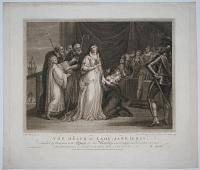
The Death of Lady Jane Gray. Dedicated by Permission to the Queen by Her Majesties most Dutiful and Devoted Servant, W:Martin. From the Original Picture in the Town Hall, Norwich.
Wm,, Martin pinxit. Francis Bartolozzi R.A. Historical Engraver to His Majesty sculp.
London, Publish'd Sepr. 1: 1790, by Wm. Martin Leicester Square, & Wm. Dickinson Engraver No. 158 New Bond Street. Size of the PICTURE 10 FT 4, by 9 FT.
Stipple and etching in stipple frame, printed in brown ink, published state, 405 x 450mm. 16 x 17¾". A good impression.
Lady Jane Grey (1536/1537 – 1554), also known as The Nine Days' Queen, was a young English noblewoman who occupied the English throne from 10 until 19 July 1553 and was executed for high treason. Here she stands with a book in one hand, looking up to left, one of her ladies kneeling and clinging to her left wrist protectively; a bishop stands to left, pointing at an open Bible held by a server and exhorting her to prayer, while a soldier stands in a full suit of armour in the far right and the executioner awaits. Other ladies weep nearby. A great-granddaughter of Henry VII by his younger daughter Mary, Jane was a first-cousin-once-removed of Edward VI. The teenage King left her the Crown in his will, thus trying to keep England protestant and subverting the claims of his half-sisters Mary and Elizabeth under the Third Succession Act. During her short reign Jane resided in the Tower of London and never to left the premises again. She became a prisoner when the Privy Council decided to change sides and proclaim Mary queen. See the companion print ref:18271. After William Martin (1753 - c.1831). Martin painted history paintings and presented two to his native Norwich in 1787. He had worked as an assistant to Cipriani and admired Kauffmann. From the Norman Blackburn Collection. Collection N. Rapp.
[Ref: 18270] £350.00
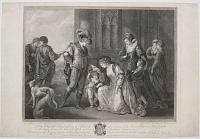
Lady Elizabeth Grey imploring of Edward IV the restitution of her deceased Husbands Lands, forfeited in the dispute between the houses of York and Lancaster. Rapin's Hist, Vol V, Page 26. Dedicated to the Queen by her Majesty's dutiful and most obedient humble Servant W.W.Ryland.
Angelica Kauffman ex academia Regali Londini pinx.t. Guliemus Wynne Ryland Chalcographus Regis Britannia sculp.t.
Publish'd as the Act directs March 1, 1780 for the Proprietor W.W.Ryland N.o.159 Strand London.
Stipple. 390 x 330mm (15½ x 13"). Trimmed to plate top and bottom.
A scene in which Lady Elizabeth Grey begs Yorkist king Edward IV for the return of the lands of her late husband Sir John Grey of Groby, who died fighting for the Lancastrians in the Second Battle of St Albans in 1641. Elizabeth kneels down before the king who takes her hand, several courtiers stand around and Elizabeth's two sons Richard and Thomas stand by her. Elizabeth Grey would go on to marry Edward in 1464.
[Ref: 36867] £260.00
(£312.00 incl.VAT)

Lady Elizabeth Grey, at the feet of Edward the Fourth, soliciting the restoration of her late Husband's forfeited lands, A.D. 1465. Acta Historica Reginarum Angliae. Plate V. Engraved from the Original Drawing, of the same dimensions in the Possession of Mr. V. Green. To Her Most Catholic Majesty Louisa Queen of Spain &c. &c. &c. This plate is Most Humbly Dedicated By Her Majesty's Most Devoted and Obedient humble Servant Valentine Green.
Drawn by J. Gerhard Huck. Engraved by V. Green Mezzotinto Engraver to his Majesty & the Elector Palatine.
Publish'd Oct.r 18.th 1791 by V. & R. Green Newman Street, Oxford Street, London.
Mezzotint, platemark 490 x 625mm (19¼ x 24½"). Creasing; uncut, large margins.
Elizabeth Woodville solicits the restoration of the lands of her first husband, Sir John Grey, who was killed at the Second Battle of St. Albans. After Grey's death his lands appear to have been forfeited, and in her poverty Woodville made personal suit to the king for their return. After she refused offers from Edward IV to be his paramour, the king determined to marry her. The scene depicted would have taken place in 1461, rather than 1465 as stated here. Plate five of 'Acta Historicae Reginarum Angliae' by the celebrated mezzotinter Valentine Green (1739-183) from drawings by his former student Johann Gerhard Huck (c.1759-1811), with parallel text in French. Whitman: 252 II of II; CS: 153.5 Ex Collection of Hon. Christopher Lennox-Boyd.
[Ref: 23054] £320.00

Elisabeth Grey Supliant Edouard IV. Pour la Resatitution des Beins de Defunt Son Mari. Lady Elizabeth Grey imploring of Edward IV the restitution of her deceased Husbands Lands, forfeited in the dispute between the houses of York and Lancaster. Rapin's Hist. Vol V. Pag. 26. Dedicated to the Queen by her Majesty's dutiful and most obedient humble Servant W. Wynne Ryland.
d'Apres Angelique Koffman et Ryland. M.elle Bareuille Sculp.
Publish'd as the Act directs March, i. 1780 for the Proprietor W.W. Ryland No 159 Strand London. A Paris chez Chaillon Salle neuve du Palais Marchand.
Stipple, printed in brown. 345 x 405mm (13¼ x 16"). Repaired tears, one entering top printed border.
Elizabeth Woodville begs Edward IV for the return of the land of her husband, Sir John Grey, forfeited after he was killed fighting on the losing side at the Second Battle of St. Albans in 1461. Much taken by the widow, Edward pursues Elizabeth and eventually marries her, the first time a king of England married one of his subjects. Their ten children included the Princes in the Tower and Elizabeth of York, wife of Henry VII The engraver, Mademoiselle Bareuille, has slavishly copied Ryland's plate, even the English text, making it look like a re-issue of the original, but it is a different plate. See BM 1872,1012.1621 for the original.
[Ref: 54213] £320.00

The Dukes of Northumberland and Suffolk praying Lady Jane Gray to accept the Crown. Humes Qto. Edn. 3 Vol:351.
G.B. Cipriania [sic] R.A. Invent. Frans. Bartolozzi R.A. Sculpt.
Published Feby. 14;1786 by W. Palmer No.163 Strand.
Stipple and etching printed in sanguine, published state, 320 x 390mm. 12½ x 15¼". Vertical creasing and some light foxing; glued to backing sheet; faint mount burn in very wide margins; tear to left.
Lady Jane Grey, seated at a table, holding an open book; next to her, a gentleman holding a charter; in the middle, the two Dukes presenting to her a crown and a sceptre. After Giovanni Battista Cipriani (1727 - 1785). De Vesme 528, III of III.
[Ref: 25938] £190.00
(£228.00 incl.VAT)
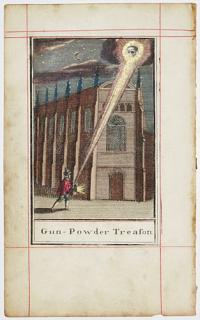
Gun-Powder Treason.
[Anon., c.1700.]
Hand-coloured engraving from an unidentified publication; image surrounded by red lines. Sheet: 195 x 120mm (7¾ x 4¾").
The eye of heaven condemns Guy Fawkes, who uses a torch to guide him towards the Houses of Parliament at night. The Gunpowder Plot or Gunpowder Treason Plot of 1605, was a failed assassination attempt against King James I of England and VI of Scotland by a group of provincial English Catholics led by Sir Robert Catesby. The plan was to blow up the House of Lords during the State Opening of Parliament on 5 November 1605, as the prelude to a popular revolt in the Midlands during which James's nine-year-old daughter, Princess Elizabeth, was to be installed as the Catholic head of state. Guy Fawkes (1570 - 1606), who had 10 years of military experience fighting in the Spanish Netherlands in suppression of the Dutch Revolt, was given charge of the explosives.
[Ref: 43652] £130.00
(£156.00 incl.VAT)
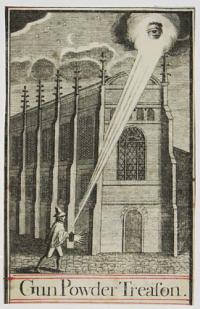
Gun-Powder Treason.
[Anon., c.1700.]
Engraving from an unidentified publication, sheet 120 x 80mm (4¾ x 3¼). Rare.
The eye of heaven condemns Guy Fawkes, who uses a torch to guide him towards the Houses of Parliament at night. The Gunpowder Plot or Gunpowder Treason Plot of 1605, was a failed assassination attempt against King James I of England and VI of Scotland by a group of provincial English Catholics led by Sir Robert Catesby. The plan was to blow up the House of Lords during the State Opening of Parliament on 5 November 1605, as the prelude to a popular revolt in the Midlands during which James's nine-year-old daughter, Princess Elizabeth, was to be installed as the Catholic head of state. Guy Fawkes (1570 - 1606), who had 10 years of military experience fighting in the Spanish Netherlands in suppression of the Dutch Revolt, was given charge of the explosives. For the image in reverse see ref. 18265
[Ref: 37648] £120.00
(£144.00 incl.VAT)
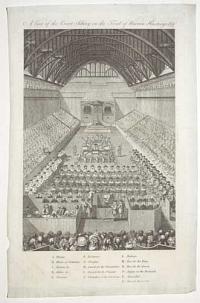
A View of the Court Sitting on the Trial of Warren Hastings, Esq.r.
[n.d., c.1788.]
Etching. 330 x 200mm (11¾ x 8"). Creases.
The impeachment trial of Warren Hastings, former Governor of the Presidency of Fort William (Bengal), at the Court of Peers in Westminster Hall, the galleries packed with spectators, with a 16-point key.
[Ref: 55325] £280.00
(£336.00 incl.VAT)

The Heretical Synod at Salters-Hall.
[n.d., c.1719.]
Engraving. Sheet 185 x 115mm (7¼ x 4½"). Trimmed.
The interior of the meeting house adjoining the Salters' Hall in Walbrook, with Four Moderators. On the sheet once atttached it states in ink that this was by Hogarth and frontis to a pamphlet called "the Scourge". In 1719 the Salters' Hall debates split the dissenting community on the issue of whether ministers should be obliged to subscribe to the orthodox doctrine of the Trinity. The print is possibly the frontispiece to Thomas Lewis, ''The anatomy of the Heretical Synod of Dissenters at Salter's Hall ... collected from their late blasphemous writings ... by the author of the Scourge, in a letter to a country friend'', 1719.
[Ref: 56276] £280.00
(£336.00 incl.VAT)
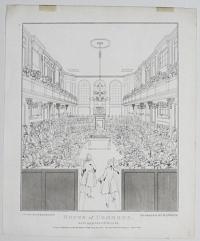
House of Commons, as it appeared in 1741/2.
Drawn by Gravelot. Engraved by W.J. White.
London, Published as the Act directs 1st. Augt. 1809, by John Thomas Smith, No.4, Polygon, Somers Town.
Etching in outline, image 265 x 220mm. 10½ x 8¾". Trimmed to platemark
Interior of the chamber of the old House of Commons, with members seated along the benches on both sides, and the Speaker Arthur Onslow presiding. Copy of an engraving by Hubert Gravelot (1699 - 1773).
[Ref: 26709] £130.00
(£156.00 incl.VAT)

A View of the House of Commons in the Session 1741/2. To the Rt. Honble. Arthur Onslow Esqr. Speaker of the House of Commons, This Plate is most humbly Dedicated by his Honour's most oblig'd and most obedient hunble Servant John Pine Bluemantle.
London, Printed for Bowles & Carver 69 St. Pauls Church Yard and Robert Wilkinson 58 Cornhill [n.d., c.1800].
Etching and engraving, sheet 470 x 640mm. 18½ x 25¼" Trimmed to plate. Vertical centre crease and fold. Some scuffs and marks to the title area and centre image.
At the centre a view of the chamber of the old House of Commons, with members seated along the benches on both sides, and the Speaker presiding. Either side two columns of lettering listing the names of the Speakers, from 1259 to 1747. The whole set into a decorative rococo frame, with crest of Arthur Onslow, the then Speaker, below. A reissue on wove paper of an earlier plate.
[Ref: 14266] £480.00
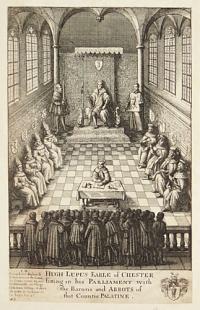
Hugh Lupus Earle of Chester sitting in his Parliament with the Barons and Abbots of that Countie Palatine. P.M. Praenobilis Richarda Grosvenour de Eaton in Comit Cestr: Eq/ aur et Baronetti [...]
[By Wenceslaus Hollar, 1656]
Etching, sheet 290 x 180mm (11½ x 7"). Trimmed and glued to backing sheet.
Hugh of Avranches sits on a throne, flanked by abbots and barons. This plate was first published in Daniel King's 'The Vale-Royall of England, or, The County Palatine of Chester Illustrated' (1656), which included several etchings by Hollar. This later state (identified by the number '48' in the lower left corner) was published in the 'Monasticon' (1718). Etched by Wenceslaus Hollar (1607-77), Bohemian printmaker from a Protestant background (although he later converted to Catholicism) who spent most of his career working in England. Hollar's technical skill has ensured that his prints have always been keenly collected, and comprehensive collections of his work are institutions in London, Berlin and Prague. Pennington 529 iv/iv
[Ref: 45260] £180.00
(£216.00 incl.VAT)
![[Three images relating to plots against James I]](img-thumbnail/jpegs/42619.jpg)
[Three images relating to plots against James I] Watson seducing Noblemen [&] The Powder Plot [&] Execution of the Conspirators In the Gunpowder Plot in the Year 1606
F.H. [F. Hulsius sc., first two only]
[From 'A Thankfull Remembrance of Gods Mercie' London: Printed by Aug. Math[ewes] for Robert Mylbourne and Humphrey Robinson, 1630, first two] Published May 1 1795 by J. Caulfield [third]
Three engravings, rare, dimensions approx 70 x 105mm (2¾ x 4") [first two] and 160 x 195mm (6¼ x 7¾") [third] All trimmed and glued to same backing sheet.
'Watson seducing Noblemen': William Watson, a Catholic priest, blessing a group of gentlemen involved in a plot against James I; in the background, one of them, Sir Griffin Markham, is pardoned at the point of execution. With Guy Fawkes planning the Gunpowder Plot and the execution of the conspirators. The first two, earlier images were engraved by German printmaker Hulsius or Friedrich von Hulsen (1580 - 1665). In 1627, he was briefly in London, where most of his work was connected with Protestant propaganda, and included these illustrations for the bishop of Chichester George Carleton's 'A Thankfull Remembrance of Gods Mercy'. This book was first published in 1624 and ran to several editions, and celebrated the defeat of the Spanish Armada and the discovery of the Gunpowder Plot. For 'Watson seducing nobleman' offered separately see ref. 12298; for 'Execution of the Conspirators' offered separately see ref. 42034; for another illustration from 'A Thankfull Remembrance' see ref
[Ref: 42619] £280.00
(£336.00 incl.VAT)
![[James II Escaping.] De geweesene Koning Jacobus vlucht, na zyn nederlaag by de Revier Boyne te Waterford uyt Ierland. Ao. 1690.](img-thumbnail/jpegs/42943.jpg)
[James II Escaping.] De geweesene Koning Jacobus vlucht, na zyn nederlaag by de Revier Boyne te Waterford uyt Ierland. Ao. 1690.
Hugo Allard fecit.
Carolus Allard Excudit Cum Privilegio Ord: Holl: et Westsrisse. [n.d., c. 1690.]
Engraving. Sheet: 245 x 295mm (9½ x 11½"). Trimmed to image at top and tipped into album sheet.
A scene showing James II fleeing Ireland after his defeat at the Battle of the Boyne in 1690. A crowd hurriedly clamber onto a ship waiting, a crowd push a boat containing Father Petre out into the sea.
[Ref: 42943] £360.00
![[Allegory of James II fleeing England and arriving in Ireland]](img-thumbnail/jpegs/42592.jpg)
[Allegory of James II fleeing England and arriving in Ireland] Engelants schoulwtoneel, verbeeldende het vlugte van Jacobus II. Koning van Groot Brittanyen [...] [parallel text in French]
A. Schoonbeek del et fec [in image lower right]
in Amsterdam by Adr: Schoonebeek in de kalverstraat [c.1691]
Etching, sheet 150 x 190mm (5¾ x 7½"). Trimmed and glued to backing sheet.
After William of Orange landed at Torbay in November 1688, James II left London at the second time of asking (the first time his boat was intercepted at Faversham and a body of guards had to come and return him to London) and fled to France. Louis XIV had lavishly refurbished the chateau of St Germain-en-Laye, near Paris, for James and his family. It was the perfect environment for James and his exiled court, and if he had his own way he probably never would have left. Louis XIV, however, wanted James to travel to Ireland, and from there attempt to recover his crown from the insurgent William. Etching from a set of scenes from the Glorious Revolution and related events published by Adriaan Schoonebeek (1661-1705), Dutch printmaker who studied under Romeyn de Hooghe and later moved to Moscow to set up a printmaking workshop for Peter the Great.
[Ref: 42592] £230.00
(£276.00 incl.VAT)
![[Louis XIV receiving James II and Mary of Modena]](img-thumbnail/jpegs/36932.jpg)
[Louis XIV receiving James II and Mary of Modena] De Koning van Vranckryck, ontfangt den gevlugte Koning en Koninginne van Engelant. fig 10.
[Anon, c.1689]
Engraving with very large margins, platemark 185 x 140mm (7¼ x 5½").
Following the Glorious Revolution of 1688 (as a result of which William of Orange would replace James II as King of England, Scotland and Ireland), William allowed James to escape to France, where Louis XIV offered him a palace and pension.
[Ref: 36932] £130.00
(£156.00 incl.VAT)
![[Profile portrait of James II, with scenes showing (l-r) Mary Modena leaving Whitehall Palace in a barge; the queen transferring to the French ship the Assurance; and arriving at Calais]](img-thumbnail/jpegs/42836.jpg)
[Profile portrait of James II, with scenes showing (l-r) Mary Modena leaving Whitehall Palace in a barge; the queen transferring to the French ship the Assurance; and arriving at Calais] Herstelling der Waere Godsdienst en Grondwetten in G: Brittanien. Door S.K.H. [...]
[by Romeyn de Hooghe, 1689]
Etching sheet 195 x 555mm (7½ x 21¾"). Tipped into backing sheet; fold through centre. Section of larger print.
Top section of a large satire comprising eleven scenes from the flight of James II and Mary of Modena which precipitated the Glorious Revolution in which William III came to the throne. Etched by Romeyn de Hooghe (1645-1708), exponent of the late Dutch Baroque best known for his political caricatures of Louis XIV and his prints glorifying William III and the Glorious Revolution. De Hooghe's output as an artist was broad, however, and he had other talents and responsibilities: in 1689 he was placed in charge of obtaining building materials for the royal hunting lodge of Het Loo; the same year he became a Doctor of Law at Harderwijk University; he designed ceiling paintings for municipal buildings and church windows; and he wrote several political and historical treatises. Landwehr p.152
[Ref: 42836] £260.00
(£312.00 incl.VAT)
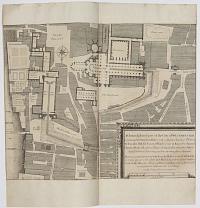
A Groundplot of part of the City of Westminster. Containing Westminster-Abby (or the Collegiate Church of St Peter) Westminster-Hall, The Court of Wards [...]
[1687]
Engraving, sheet 340 x 435mm (13½ x 17"). Trimmed; central fold; false margins top and bottom.
An early plan of Westminster, orientated with north to the bottom, showing the route taken from Westminster Hall to Westminster Abbey by James II on the day of his coronation. Illustration to Francis Sandford, 'The history of the coronation of the Most High, Most Mighty, and Most Excellent Monarch, James II, by the grace of God, King of England, Scotland, France, and Ireland, defender of the faith, &c. And of his royal consort, Queen Mary' (London, 1687). Sandford worked for two years with his fellow herald Gregory King to produce this record of the coronation rituals, which included twenty-seven lavish engravings of the sumptuous feasts, processions and fireworks in a style previously unseen in the British Isles. Unfortunately for Sandford, the book appeared shortly before the Glorious Revolution which saw James II flee the country, and the authors barely cleared their expenses.
[Ref: 42917] £450.00
![[Westminster Abbey before the coronation of James II]](img-thumbnail/jpegs/42916.jpg)
[Westminster Abbey before the coronation of James II] A Prospect of the Inside of the Collegiate Church of St Peter in Westminster, from the Quire to the East End, With the Furniture thereof [...]
S Moore delin et sculp [1687]
Engraving, sheet 390 x 505mm (15¼ x 19¾"). False margins top and bottom.
Westminster Abbey (formally titled the Collegiate Church of St Peter at Westminster) as arranged for the coronation of James II and Mary of Modena on 23 April 1685. Illustration to Francis Sandford, 'The history of the coronation of the Most High, Most Mighty, and Most Excellent Monarch, James II, by the grace of God, King of England, Scotland, France, and Ireland, defender of the faith, &c. And of his royal consort, Queen Mary' (London, 1687). Sandford worked for two years with his fellow herald Gregory King to produce this record of the coronation rituals, which included twenty-seven lavish engravings of the sumptuous feasts, processions and fireworks in a style previously unseen in the British Isles. Unfortunately for Sandford, the book appeared shortly before the Glorious Revolution which saw James II flee the country, and the authors barely cleared their expenses.
[Ref: 42916] £260.00
(£312.00 incl.VAT)
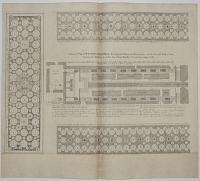
A Ground Plott of Westminster Hall, shewing the Position and Dimensions of the severall Tables, Seats, Cupboards, Galleries &c on the day of their Majesties Coronation 23 Apr. 1685.
[1687]
Engraving, sheet 445 x 505mm (17½ x 19¾").
Plan of Westminster Hall showing seating arrangements for the coronation of James II, with arrangements of plates on different tables. Illustration to Francis Sandford, 'The history of the coronation of the Most High, Most Mighty, and Most Excellent Monarch, James II, by the grace of God, King of England, Scotland, France, and Ireland, defender of the faith, &c. And of his royal consort, Queen Mary' (London, 1687). Sandford worked for two years with his fellow herald Gregory King to produce this record of the coronation rituals, which included twenty-seven lavish engravings of the sumptuous feasts, processions and fireworks in a style previously unseen in the British Isles. Unfortunately for Sandford, the book appeared shortly before the Glorious Revolution which saw James II flee the country, and the authors barely cleared their expenses.
[Ref: 42913] £140.00
(£168.00 incl.VAT)
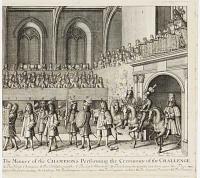
The Manner of the Champions Performing the Ceremony of the Challenge.
Yeates fc. [1687]
Engraving, platemark 230 x 260mm (9 x 10¼"). Trimmed to image on left.
The King's Champion riding into Westminster Hall at the banquet following the coronation of James II, having thrown down the gauntlet. Illustration to Francis Sandford, 'The history of the coronation of the Most High, Most Mighty, and Most Excellent Monarch, James II, by the grace of God, King of England, Scotland, France, and Ireland, defender of the faith, &c. And of his royal consort, Queen Mary' (London, 1687). Sandford worked for two years with his fellow herald Gregory King to produce this record of the coronation rituals, which included twenty-seven lavish engravings of the sumptuous feasts, processions and fireworks in a style previously unseen in the British Isles. Unfortunately for Sandford, the book appeared shortly before the Glorious Revolution which saw James II flee the country, and the authors barely cleared their expenses.
[Ref: 42911] £230.00
(£276.00 incl.VAT)
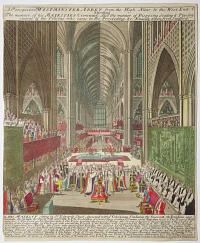
A Perspective of Westminster Abbey from the High Altar to the West End 1. Shewing. The manner of his Majesties Crowning: Also the manner of Disposing Seating & Placing several of the Persons who came in the Proceeding. & c: Exactly taken from Sandford.
[After William Sherwin]
Printed for Bowles & Carver & R. Wilkinson. [n.d. c.1780]
Hand coloured engraving. Sheet 285 x 235mm (11¼ x 9¼"). Trimmed within plate.
The coronation of James II; interior of Westminster Abbey, the crowning of the king at bottom centre; based on an illustration to Francis Sandford's, 'The History of the Coronation of the Most High, Most Mighty, and Most Excellent Monarch, James II' (London, 1687).
[Ref: 60467] £130.00
(£156.00 incl.VAT)
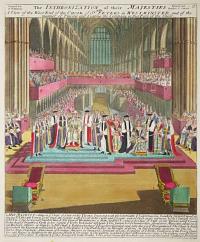
The Inthronization of their Majesties. 2. Also. A View of the West End of the Choir of S.t Peters in Westminster and of the manner of Placing and Seating the Company in that Part of the Choir.
[After William Sherwin]
Printed for R. Wilkinson. Printed for Bowles & Carver. [n.d. c.1800]
Hand coloured engraving 280 x 235mm (11 x 9¼"), with large margins.
James II and Mary of Modena enthroned in Westminster Abbey during the king's coronation; based on an illustration to Francis Sandford, 'The History of the Coronation of the Most High, Most Mighty, and Most Excellent Monarch, James II' (London, 1687).
[Ref: 60472] £160.00
(£192.00 incl.VAT)
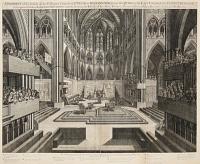
A Prospect of the Inside of the Collegiate Church of S.t Peter in Westminster, from the Quire, to the East End, With the Furniture thereof as it appeared before the Grand Proceeding entred; Shewing the Position of the Altar, Theatre, Thrones, Chairs, Pulpit, Benches, Seats and Galleries.
S. Moore delin: et sculp.
[n.d., c.1685.]
Rare engraving. Sheet: 390 x 380mm (15¼ x 15"). Trimmed to image as usual. Manuscript key added below. Repaired tears and two vertical creases through image, laid on album sheet.
An interior scene showing the decoration of Westminster Abbey for the coronation of James II (1633-1701) who reigned from 1685 until he was deposed in 1688 and his Protestant daughter Mary and her husband William of Orange crowned in his stead. The scene shows the various thrones and chairs in which James and his wife Mary were crowned on the 23rd April 1685.
[Ref: 42036] £280.00
(£336.00 incl.VAT)
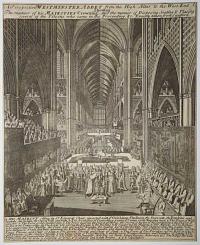
A Perspective of Westminster Abbey from the High Altar to the West End 1. Shewing. The manner of his Majesties Crowning: Also the manner of Disposing Seating & Placing several of the Persons who came in the Proceeding. & c: Exactly taken from Sandford.
[After William Sherwin]
Printed for T. Bowles in St. Pauls Churd Yard & John Bowles [illegible] at the bLack Horse in Cornhill. [n.d. c.1724]
Engraving. Sheet 285 x 235mm (11¼ x 9¼"). Trimmed within plate.
The coronation of James II; interior of Westminster Abbey, the crowning of the king at bottom centre; based on an illustration to Francis Sandford's, 'The History of the Coronation of the Most High, Most Mighty, and Most Excellent Monarch, James II' (London, 1687).
[Ref: 60468] £130.00
(£156.00 incl.VAT)
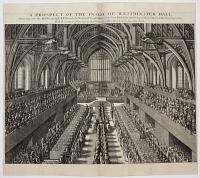
A Prospect of the Inside of Westminster Hall, Shewing how the King and Queen, with the Nobility and Others, did Sit at Dinner on the day of the Coronation, 23 April 1685 [...]
S Moore fecit [1687]
Engraving, sheet 390 x 505mm (15¼ x 19¾"). False margins top and bottom.
Banquet at Westminster Hall, held as part of the coronation of James II and Mary of Modena on 23 April 1685. Illustration to Francis Sandford, 'The history of the coronation of the Most High, Most Mighty, and Most Excellent Monarch, James II, by the grace of God, King of England, Scotland, France, and Ireland, defender of the faith, &c. And of his royal consort, Queen Mary' (London, 1687). Sandford worked for two years with his fellow herald Gregory King to produce this record of the coronation rituals, which included twenty-seven lavish engravings of the sumptuous feasts, processions and fireworks in a style previously unseen in the British Isles. Unfortunately for Sandford, the book appeared shortly before the Glorious Revolution which saw James II flee the country, and the authors barely cleared their expenses.
[Ref: 42915] £380.00
![[Plan of Westminster Abbey as arranged for coronation of James II]](img-thumbnail/jpegs/42918.jpg)
[Plan of Westminster Abbey as arranged for coronation of James II] The Ground Plot of The Collegiate Church of St Peter in Westminster With two Profiles relating thereunto [...]
[1687]
Engraving, sheet 375 x 510mm (14¾ x 19¾"). Trimmed lower edge with false margin added; torn along central fold
Illustration to Francis Sandford, 'The history of the coronation of the Most High, Most Mighty, and Most Excellent Monarch, James II, by the grace of God, King of England, Scotland, France, and Ireland, defender of the faith, &c. And of his royal consort, Queen Mary' (London, 1687). Sandford worked for two years with his fellow herald Gregory King to produce this record of the coronation rituals, which included twenty-seven lavish engravings of the sumptuous feasts, processions and fireworks in a style previously unseen in the British Isles. Unfortunately for Sandford, the book appeared shortly before the Glorious Revolution which saw James II flee the country, and the authors barely cleared their expenses.
[Ref: 42918] £90.00
(£108.00 incl.VAT)
![[James II in his palace with parliament entering; revoking his decision to form a parliament; arriving in Ambleteuse by boat; and arriving in St Germain-en-Laye]](img-thumbnail/jpegs/42559.jpg)
[James II in his palace with parliament entering; revoking his decision to form a parliament; arriving in Ambleteuse by boat; and arriving in St Germain-en-Laye] de k: gaet over bloulange na Parys en: St germain [...]
[Anon., c.1688]
Two etchings, both approx 165 x 110mm (6½ x 4¼"). Trimmed. Both tipped into same backing sheet.
Scenes depicting James II's departure from England in 1688. After William of Orange landed in England in November 1688, James decided to flee. Leaving London, he got as far as Faversham in Kent before his boat was intercepted and he needed a company of guards to rescue him. James then briefly attempted resume government before receiving a request from William to remove himself. This he did, travelling to Rochester in Kent and from there on to France. He landed in Ambleteuse, near Boulogne, on Christmas day, and from there travelled to the chateau of St Germain-en-Laye which Louis XIV had given him. These etchings are all copied from prints in a set of twenty-five by Adriaan Schoonebeek depicting events in the struggle for the British crown from the civil war to the coronation of William III and Mary II.
[Ref: 42559] £260.00
(£312.00 incl.VAT)
![[James II intercepted at Faversham; embarking at Rochester; arriving in Ambleteuse; and riding from Boulogne to Paris]](img-thumbnail/jpegs/42565.jpg)
[James II intercepted at Faversham; embarking at Rochester; arriving in Ambleteuse; and riding from Boulogne to Paris] Kon. Jacob word tot Feversham opgeworpen: aldaar mishandeld, en verzeekerd [...]
[Anon., c.1688]
Etching, rare, sheet 255 x 295mm (10 x 11½"). Tipped into backing sheet.
Scenes depicting James II's departure from England in 1688. After William of Orange landed in England in November 1688, James decided to flee. Leaving London, he got as far as Faversham in Kent before his boat was intercepted and he needed a company of guards to rescue him. James then briefly attempted resume government before receiving a request from William to remove himself. This he did, travelling to Rochester in Kent and from there on to France. He landed in Ambleteuse, near Boulogne, on Christmas day, and from there travelled to the chateau of St Germain-en-Laye which Louis XIV had given him. These etchings are all copied from prints in a set of twenty-five by Adriaan Schoonebeek depicting events in the struggle for the British crown from the civil war to the coronation of William III and Mary II.
[Ref: 42565] £280.00
(£336.00 incl.VAT)
![[James II lands at Kinsale in Ireland]](img-thumbnail/jpegs/42591.jpg)
[James II lands at Kinsale in Ireland] Koning Jakobus II lant to Kingsal in Yrlant [parallel text in French]
Ad. Schoonebeek excudit [1691]
Etching, sheet 145 x 190mm (5¾ x 7½"). Trimmed and glued to backing sheet.
After William of Orange landed at Torbay in November 1688, James II left London at the second time of asking (the first time his boat was intercepted at Faversham and a body of guards had to come and return him to London) and fled to France. Louis XIV had lavishly refurbished the chateau of St Germain-en-Laye, near Paris, for James and his family. It was the perfect environment for James and his exiled court, and if he had his own way he probably never would have left. Louis XIV, however, wanted James to travel to Ireland, and from there attempt to recover his crown from the insurgent William. This scene shows James landing at Kinsale in Ireland on 12 March 1689. William III (as he was crowned in April 1689) landed in Ireland in mid-June, and defeated James at the battle of the Boyne on 1 July 1689. This precipitated James' final exile in France. Etching from a set of scenes from the Glorious Revolution and related events published by Adriaan Schoonebeek (1661-1705), Dutch printmaker who studied under Romeyn de Hooghe and later moved to Moscow to set up a printmaking workshop for Peter the Great.
[Ref: 42591] £230.00
(£276.00 incl.VAT)
![[The Jealousy of Lord Darnley, Husband of Mary Queen of Scots.]](img-thumbnail/jpegs/31208.jpg)
[The Jealousy of Lord Darnley, Husband of Mary Queen of Scots.]
[G.B. Cipriani R.A. del. F. Bartolozzi R.A. sculp.]
[Published according to Act of Parliament, 19 April 1787, by Anne Bryer, N.o 5. Poland Street, Soho.]
Stipple and etching very large margins, printed in brown; except publication line; proof before all letters. Plate 326 x 389mm (12¾ x 15¼").
A musical image showing inside of room, Mary, Queen of Scots playing a harpsichord; a young boy holding up a sheet of music; on the right, David Rizzio, playing a mandolin; on the left, Lord Darnley, his right fist clinched in anger; in the background on the right, two ladies, one holding a book. De Vesme: 533: iv/vi. Tuer: 1232. Collection: Northwick.
[Ref: 31208] £360.00

The description of the poisoning of king John by a moonke of Swinstead abbeie in Lincolnshire.
[n.d., c.1590.]
Woodcut set in letterpress. Sheet 340 x 255mm (13½ x 10"). Woodcut trimmed on right, laid on album paper.
A woodcut with six panels illustrating scenes of the poisoning of King John by a monk of Swineshead Abbey (not Swinstead, an error also in Shakespeare's 'King John'). The story tells that John was a threat to the abbey. A Brother Simon went to Abbot William and was granted absolution before giving the king a cup poison obtained from a toad. Because John's taster was not available, Simon drank from the cup first but returned to his cell before dying. The king fell ill and died at Newark Castle. From John Foxe’s Book of Martyrs, told as an illustration of the treachery of the Catholic church. BM 1953,0411.74, a cutting of two panels of this print, ''a 16th-century edition''.
[Ref: 62318] £160.00
(£192.00 incl.VAT)
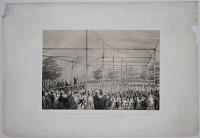
The Jubilee Meeting of the Baptist Missionary Society, held at Kettering (Northampton) on Wednesday June 1st. 1842.
From a drawing taken on the spot, by the Rev.d AG Fuller. On Stone by E. Walker.
R. Cartwright lith. Warwick Pl. Holborn [n.d. c.1842.]
A rare lithograph. 386 x 558mm. 15¼ x 22". Tearing and creasing into right-hand margin.
One of many missionary meetings in Kettering, England. William Knibb (1803-1845) was an English Baptist minister and missionary to Jamaica who is chiefly known for his work to free slaves; seen here in 1842 preaching in answer to criticism of the conduct of missionaries over the slaves. Here also he has returned to his home town to celebrate the golden jubilee of the Baptist Missionary Society.
[Ref: 20295] £260.00
(£312.00 incl.VAT)
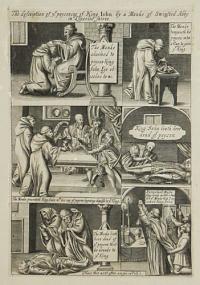
The description of y.e poysoning of King John by a Monke of Swinsted Abby in Lincolne shiere.
[n.d., c.1684.]
Engraving. Sheet: 260 x 180mm (10¼ x 7''). Trimmed and laid on album sheet.
A series of vignettes in two columns showing the supposed murder of King John (1166-1216) who in reality died of dysentery. Illustration to the ninth edition of John Foxe, 'Acts and Monuments' ('Book of Martyrs')
[Ref: 51035] £240.00
(£288.00 incl.VAT)

King John Submits to the Barons, and agrees to sign the Great Charter of British Liberties.
Monnet delin. Barlow sculp.
[n.d., c.1790.]
Engraving. Plate: 125 x 185mm (5 x 7¼"). Small margins. Cut on left to plate.
An scene depicting King John's meeting with the rebel barons at Runnymede on 15th June 1215 and the signing of the Magna Carta. Though the charter of 1215 failed to resolve the differences between the barons and the King it is seen as the basis of modern British law and civil liberties.
[Ref: 38600] £60.00
(£72.00 incl.VAT)
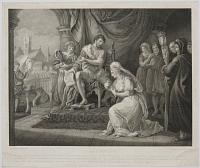
Lady Godiva. The citizens of Coventry having offended their first Lord Leofrike, had their privileges infringed and themselves oppressed with many heavy tributes being pitied by his wife Lady Godiva, she incessantly sued Leofrike in their behalf, as last being overcome by his importunities, he forgave them upon condition that she rode through the town naked at noon day, which was complied with on the part of the Lady and the people restored to their former rights.___See the abridgment of Speeds England Wales &c. described, _Warwickshire Chapter 26.th
Painted by W.m Hamilton. Engrav'd by C.G. Playter.
Publish'd Jan.y 1.1792 by J. & J. Boydell, Cheapside, & at the Shakespeare Gallery Pall Mall.
Stipple, lettered early proof. 330 x 395mm (13 x 15½"). Horizontal crease; cut.
Lady Godiva, 11th century Anglo-Saxon noblewoman, who rode naked through the streets of Coventry in order to gain a remission of the oppressive taxation imposed by her husband on his tenants. Here she pleads with her husband Lord Leofric to retract his tax demands.
[Ref: 28966] £70.00
(£84.00 incl.VAT)
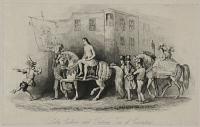
Lady Godiva and Peeping Tom of Coventry.
[n.d. c.1820.]
Engraving and etching, rare. 102 x 165mm (4 x 6½"). Laid on album sheet.
Lady Godiva, the 11th century Anglo-saxon noblewoman, who rode naked through the streets of Coventry in order to gain a remission of the oppressive taxation imposed by her husband on his tenants. The man seen at the window, was 'Peeping Tom' who after watching her ride was struck blind or dead.
[Ref: 28945] £50.00
(£60.00 incl.VAT)
![[The Manner and forme of the Archbishops Triall in the House of Peeres.]](img-thumbnail/jpegs/42116.jpg)
[The Manner and forme of the Archbishops Triall in the House of Peeres.]
W. Hollar fecit.
[London: Michael Sparke, 1646.]
Etching. Sheet 185 x 135mm (7¼ x 5¼"). Trimmed close to image.
A view of the House of Lords during the trial of Archbishop William Laud in 1644. The title and key were letterpress and are not present here (although the key is supplied in facsimile). One of those identified is the publisher of this print, Michael Sparke, a London publisher who accused Laud of Papistry by encouraging the publication of illustrated bibles, often employing 'an excellent Workman Mr Hollard'. Published in 'Canterburies doome, or, The first part of a compleat history of the commitment, charge, tryall, condemnation, execution of William Laud', 1646 Pennington 555, state ii, with signature and letters of key added (not by Hollar).
[Ref: 42116] £160.00
(£192.00 incl.VAT)

The Earl of Leicester's Visit to Amy Robsart, at Cunnor Place. This Print from a Picture in the Collection of the Earl of Egremont, Is with Permission dedicated to his Lordship by his Most Obedt. Humble. Servant H. Fradelle..
Painted by Henry Fradelle. Engraved by C. Turner Mezzotinto Engraver in Ordinary to His Majesty. Proof.
Printed by J. Lahee. London Published June 15th.1826, by H. Fradelle 8 Somerset Street Portman Square. Vide, Kenilworth by the Author of Waverley Vol. 1st. Page 150. a Paris chez Chaillouy Pertrelle Rue St. Honore.
Mezzotint. 460 x 558mm (18 x 22").
Amy Dudley, nee Rosbart, the first wife of Lord Robert Dudley, 1st Earl of Leicester. Rosbart is known for her tragic death, caused by falling down a flight of stairs. After a painting by Henri Jean-Baptiste Victoire Fradelle (1778-1865). Whitman: 729: ii. Ex: Collection of The Hon. C. Lennox-Boyd.
[Ref: 14766] £240.00
(£288.00 incl.VAT)
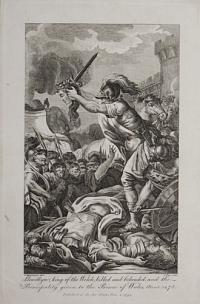
Llewellyn, King of the Welch, killed and beheaded, and the Principality given to the Prince of Wales, Anno 1278.
C. Monomet del. J. Pass sculp.
Published as the Act directs June 1, 1794.
Engraving. Plate: 120 x 190mm, (4¾ x 7½"). Small margins.
Scene depciting the moment Llywellyn the Last was beheaded by English troops following an ambush. Llywellyn was the last sovereign king of Wales before its conquest by Edward I.
[Ref: 38603] £50.00
(£60.00 incl.VAT)

Magna Carta. Regis Johannis. A.D. M.CCXV. Ex Orig. in Archiv. Eccl. Cathed. Lincoln.
James Basire Sculp.
[n.d., c.1800.]
Engraving. 470 x 505mm (18½ x 20"). Trimmed, stained, original folds, old ink mss. on reverse.
A facsimile of the Magna Carta, from the example held in Lincoln Cathedral, probably engraved for the Society of Antiquaries. Basire engraved another example of the Magna Carta for Hansard's 'Report on the Public Records of the Kingdom, Appendix'.
[Ref: 58093] £180.00
(£216.00 incl.VAT)

Magna Carta. Regis Johannis. With the Seals of the Kings Securities to Magna Charta and Shields on ye Barrons in Arms.
Facsimile by Express Permission from the original Document in the British Museum.
London Published by Chatto & Windus 214 Piccadilly. [n.d., c.1880.]
Hand coloured lithograph. Sheet size: 760 x 555mm (295 x 21¾"). Sheet toned. Laid on board
A facsimile of the Magna Carta, with a series of hand-coloured (some finished in gold) coats of arms of the Barons in surrounding the text, and the Seals of the Kings Securities below.
[Ref: 39339] £780.00
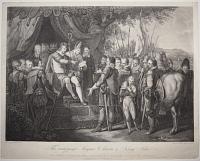
The ratifying Magna Charta by King John. To those Gentlemen who advanced the Purchase Money for this Place, it is most respectfully inscribed by their Obliged and Obedient Servant, Mary Ryland.
Painted by J.H. Mortimer. Engraved by William Wynne Ryland.
Publish'd May 4th; 1785 for the Proprietors at W Palmers No. 163 Strand.
A rare engraving. 500 x 620mm (19¾ x 24½"). Trimmed close to plate, a few nicks in edges.
King John confronted by his barons in 1215. Despite the title it was only after the death of John in 1216 that either Crown or nobility attempted to abide by the terms of the document. Despite Ryland's name as engraver this plate is not all his work, the result of him being executed for forging bills of exchange in 1783. His widow continued his business, and had Bartolozzi finish this plate. De Vesme: 576.
[Ref: 47327] £280.00
(£336.00 incl.VAT)
![By Permission of [the]… Trustees of the Cottonian Library. This Plate Being a Correct Copy of King John's Great Charter [...].](img-thumbnail/jpegs/39334.jpg)
By Permission of [the]… Trustees of the Cottonian Library. This Plate Being a Correct Copy of King John's Great Charter [...].
Sold by J. Pine, in Old Bond Street Near Piccadilly and by the Bookseller of London and Westminster. [n.d., c.1733.]
Early hand coloured engraving. Sheet size: 720 x 510mm (28¼ x 20"). Damaged. Fine frame.
A facsimile of the Magna Carta, with a series of 25 hand-coloured coats of arms of the Barons in columns on either side, a heading and dedication panel at the top and bottom, and a panel containing notes and a representation of the remains of King John’s Great Seal at the bottom. All panels surrounded by oak leaf, acorn and bell decorated borders.
[Ref: 39334] £1,500.00
![[Glorious Revolution] De Koningin en Prins van Walles, landen te Calais, en worden van d'Governeur ontfangen.](img-thumbnail/jpegs/53743.jpg)
![[The arrival of William of Orange in London, 28 January 1689]](img-thumbnail/jpegs/42564.jpg)
![[Arrival in England of the Princess of Orange, 12 February 1689]](img-thumbnail/jpegs/42561.jpg)
![[Louis XIV welcomes James to his Paris at St Germain-en-Laye]](img-thumbnail/jpegs/42560.jpg)
![[William of Orange's Invasion of England.]](img-thumbnail/jpegs/42976.jpg)













![[Three images relating to plots against James I]](img-thumbnail/jpegs/42619.jpg)
![[James II Escaping.] De geweesene Koning Jacobus vlucht, na zyn nederlaag by de Revier Boyne te Waterford uyt Ierland. Ao. 1690.](img-thumbnail/jpegs/42943.jpg)
![[Allegory of James II fleeing England and arriving in Ireland]](img-thumbnail/jpegs/42592.jpg)
![[Louis XIV receiving James II and Mary of Modena]](img-thumbnail/jpegs/36932.jpg)
![[Profile portrait of James II, with scenes showing (l-r) Mary Modena leaving Whitehall Palace in a barge; the queen transferring to the French ship the Assurance; and arriving at Calais]](img-thumbnail/jpegs/42836.jpg)

![[Westminster Abbey before the coronation of James II]](img-thumbnail/jpegs/42916.jpg)







![[Plan of Westminster Abbey as arranged for coronation of James II]](img-thumbnail/jpegs/42918.jpg)
![[James II in his palace with parliament entering; revoking his decision to form a parliament; arriving in Ambleteuse by boat; and arriving in St Germain-en-Laye]](img-thumbnail/jpegs/42559.jpg)
![[James II intercepted at Faversham; embarking at Rochester; arriving in Ambleteuse; and riding from Boulogne to Paris]](img-thumbnail/jpegs/42565.jpg)
![[James II lands at Kinsale in Ireland]](img-thumbnail/jpegs/42591.jpg)
![[The Jealousy of Lord Darnley, Husband of Mary Queen of Scots.]](img-thumbnail/jpegs/31208.jpg)






![[The Manner and forme of the Archbishops Triall in the House of Peeres.]](img-thumbnail/jpegs/42116.jpg)





![By Permission of [the]… Trustees of the Cottonian Library. This Plate Being a Correct Copy of King John's Great Charter [...].](img-thumbnail/jpegs/39334.jpg)